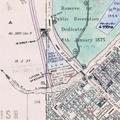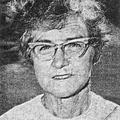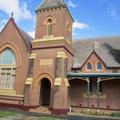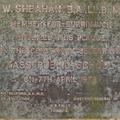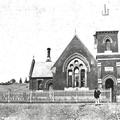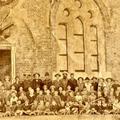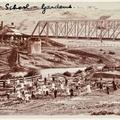< Early Canberra Government Schools
Yass Public School [1865 - 2017]
The first schools in Yass
In 1837 tenders were called for a schoolhouse to be built on one of the blocks for sale along Yass township's main street, however this didn't progress. At about the same time, Mrs Reid opened a day and boarding school at Hanley's Inn in Dutton Street. Then in 1848 Dean Lovett opened a Catholic boys' school next to the Catholic Church – later, St Augustine's. The Reverend Archdeacon Lillington opened a Church of England School next to the Rectory at about the same time. In 1860, a Mr McPhee sought parental support for a national school, however this didn't proceed.
By 1863 Mrs Wardell had a day and boarding school called 'The Willows' in Rossi Street, and the Misses Allman had a similar school called 'Creek Cottage' in Meehan Street. There was also a Presbyterian school in 1864; a Church of England school conducted by Miss Moriarty in Church Street in 1865; and the Rev and Mrs Brigstock's 'Lawhaddon' elementary Grammar School in Dutton Street. Still standing, the latter became a stationmaster's residence when the railway reached Yass in 1892.
Yass National School, 1865-1868
When the Public Instruction Act was passed in 1866, Mathew Duhigg led some local citizens in requesting that a national school be opened. Duhigg was at that time conducting a private school at North Yass, in a stone cottage owned by Mr Larkin, an innkeeper. On 16th July 1865, Duhigg wrote to the Board of National Education as follows: -
'Having lived here for some time as a private tutor, I was induced by the people of North Yass to open a morning school in that locality the result of which you will see by the return. Although there are three Denominational Schools in South Yass, those residing on the Northern side of the River, are deprived of any advantage derived from them. Many of the children from the position of their residences being obliged to ford the river. Those residing near the bridge being only a few. Parents residing two or three miles on the Northern side of the River never even think of sending their children to Yass. So that a National School at North Yass would not only be a great boon to the residents of that place and its environs, but would enhance the Board very much. There are a great many respectable persons, not only anxious to see a National school established here, but are ready and willing to contribute towards the necessary expense if the Board will assist. The Seed is sown and it depends on the Board whether it shall ever come to Maturity. I will venture to say if the board takes it in hand it will be second to none in the District'.
The 'return' referred to stated that Duhigg's present school had opened on 29th May 1865 and that 30 pupils were attending.
Supporting Mathew Duhigg, a further request was made for a national school at North Yass on 29th July, signed by the Local Patrons of Duhigg's school: Francis Larkin, R M Vaughan, Robert McJanett, Norman Barber and E Allman. They suggested that the current premises, a stone building measuring 24 x 12 feet owned by Mr Larkin, could become a national school, and that an attendance of 15 boys and 15 girls could be expected. A case was put that Mr Duhigg had been satisfactorily conducting their school and that the Patrons would like to see him appointed to the national school, if established.
In September 1865, the Patrons were informed that their proposal had been approved: aid was granted for a national school to open in the premises owned by Mr Larkin with Mathew Duhigg as teacher-in-charge. It opened that month, Duhigg renting a cottage nearby as a teacher's residence for 20 pounds a year. By December, the school had 26 boys and 27 girls enrolled and an average attendance of 36.
In August 1866, the Patrons sought financial assistance from the Board to build a permanent school. The site they proposed was 2 acres on lot 5, section 4, of Yass parish: crown land reserved for school purposes, bounded by Glebe, Pollux, Hume and Caster Streets. The planned schoolhouse was to be 50 x 20 feet, with an attached room 20 x 8 feet. However, although supported by the local school inspector, the Board chose not to proceed with this proposal.
In January 1868 Mathew Duhigg transferred to Yass Catholic Denomination School, being replaced at the national school by Mr A Watson. Then in July, the Board received an urgent telegram from Duhigg informing them that Mr Watson had 'left surreptitiously' – apparently unable to cope. After this the school closed, and for a decade Yass children could only attend either the Church of England or the Catholic school, or one of the smaller private schools.
Yass Public School opens in 1879
It was not until 1876 that fresh moves were made to re-open a public school in Yass.
An application on 5th January that year was signed by a local committee comprising James Ritchie, storekeeper; Walter Perry, surgeon; Henry Curry, shoemaker; Henry Pearce, carpenter; Henry Dodds, innkeeper; and Elijah Howard, shoemaker. As a local resident, Mr J K Hume, was offering a site that the Council of Education could lease for 99 years at a peppercorn rental, the committee urged that the school be established as soon as possible. Inspector Murray, sent to investigate the matter, reported to the Council as follows: -
'A good Public School is urgently required for Yass and should be provided without any delay. The E. C. School is not half large enough for the number of scholars attending it. Some parents complain that consideration of their children's health oblige them to deny them School Instruction, others on the same ground sent their children irregularly. The Local Board of the E. C. School are unanimous in their desire to change their school to a Public School but a legal difficulty prevents them doing so. It is intended to close the present E. C. School when the Public School is ready for opening. This is the centre of a large pastoral district and many persons would send their children to school in Yass from the outlying parts of the district if accommodation were provided for boarders'.
In July the inspector was required to submit a building form in which he advised that accommodation would be needed for 220 pupils in three departments, and that the buildings should be brick with stone dressings.
In December, the Council of Education resolved that the local committee be invited to report on whether the Church of England would be willing to rent its school buildings to the Council, at moderate cost until the new public school was ready for occupation. Apparently the Church authorities didn't accept this proposal, as no such arrangement occurred before Yass Public School opened three years later.
The new school's plans were completed in January 1877 and forwarded to the Council of Education for consideration. After a few alterations, they provided accommodation for 258 pupils in two departments, primary and infants. Primary had one room 46 x 22 feet and a second 22 x 14 feet; infants had one room 38 x 20 feet. There was also an attached inspector's room. The school residence consisted of four rooms, a kitchen and servant's room. The site chosen was on crown land granted in April 1878 for school purposes, fronting Comur Street just north of the Yass River Bridge: 2 acres, 2 roods and 24 perches in size. Over the rest of the year, Robert Beverley constructed the school at a cost of ₤4,895.
The school opened in January 1879 under the charge of James Brierly - previously a teacher at the local Church of England School. His assisting infants mistress was Miss Emma Day. On 10th February, Brierly informed the Council of Education that the school had 83 children enrolled, 50 attending on average, and that on the day of writing the attendance had been 66.5. He also requested that his daughter Alice be appointed as a pupil-teacher at the school, which was duly granted.
Two weathersheds, approved in 1881, were erected by John Colls at a cost of ₤185. The next year, the school's site was enlarged through the acquisition of adjacent land between its existing block and the Yass River: an extra 3 acres and 15 perches.
Admittance and expulsion of Aboriginal pupils in 1883
The 1880 Public Instruction Act made school attendance compulsory for all children from 6 to 14 years of age, and when the Aboriginal Protection Board was established in 1883, Aboriginal parents were encouraged to send their children to school.
In April 1883, sixteen children from various local Aboriginal camps presented themselves at Yass Public School and were enrolled by James Brierly. However a meeting of the non-Aboriginal parents promptly informed Brierly that they objected to the attendance of Aboriginal children, and threatened to withdraw all their own children if the Aboriginal children were not excluded. On the matter being referred to the Minister for Education, George Reid, the following response was sent to Henry Dodds, secretary of Yass Public School's board of management: -
'Sir - I am directed to acquaint you that the Minister of Public Instruction has had under notice your letter of the 30th April, in which you report that black and half-caste children, living a regular camp life, have been received into the Public school at Yass, and request that, for the reasons urged by you, steps may be at once taken to discontinue the attendance of these children at the school. In reply, I am to state that the Minister, having caused inquiry into the matter, is of the opinion that children living in the manner described should not be enrolled as pupils at the school. The teacher will be instructed accordingly, and will be further directed to strike off the rolls the names of such children and to refuse them admission. They could doubtless be provided for at the aboriginal stations at Warrangesda and Maloga.
[Trove: Maitland Mercury and Hunter River General Advertiser, 7 June 1883]
Accordingly, all the Aboriginal children were expelled. On the initiative of the Reverend Dean O'Keeffe however, they were accepted into St Augustine Catholic boys' school at Yass, which avoided their having to move out of the district to attend remote station schools as proposed by the minister. A report in the Burrowa News on 21st September gave due praise to Dean O'Keeffe: -
'Eighteen Aboriginal children from the various camps around Yass were collected on Monday morning by Mr Inspector Brennan, who marched them to the school prepared for them at St Augustine's. The youngsters presented a clean and healthy appearance, and appeared highly pleased at the opportunity afforded them of attending school. Dean O'Keeffe deserves great credit for his efforts in endeavouring to do something in the way of educating these poor outcasts; and it is hoped the Aborigines Protection Society will vote some of the funds at its disposal to assist in their education'.
Dean O'Keeffe arranged separate accommodation for them at St Augustine's whilst a special 'Yass Black's schoolroom' was built in the grounds. On 12 October 1883, its foundation stone was officially laid by the Dean at an assembly of over 200 pupils from the two convent schools and St Augustine's. Completed in December, it was described as 'a neat compact brick building on stone foundation'. The Aboriginal pupils, ranging in age from 5 to 14, were visited later that month by the Catholic school inspector, Thomas Brennan, Yass police magistrate Captain Fisher, and Thomas Colls MP, all of whom were favourably impressed with their situation and progress.
A growing School - to 1909
In 1883 a girls department replaced the infants department, however this arrangement was found to be unsuitable within a few years. In May 1887, Chief Inspector Maynard recommended that the school be restructured as one department. Inspector Lawford, when requested to comment, wrote on 7th June: -
'It would certainly be more economical to work this school as one department. I do not think many of the residents would object to the change and I know a good many of them are anxious for their girls to be taught by Mr Brierly. The separate girls department has not been a great success, which is however to be chiefly attributed to the feebleness of Miss Ross. As regards the staff, there are now three P.T's (pupil-teachers) and Mr Brierly: the average last qr being 135 the staff should be Teacher, asst. and one P.T. If the school be worked as one dept. I think the present staff should be retained till Christmas when one P.T. is due for training. The average will probably go over 140 then, and an Asst. can be appointed. On the whole, though somewhat reluctantly as I think a separate girls school is desirable in a town of any size, I recommend the change from 1st July next'.
Lawford's recommendation was approved, and the girls department discontinued.
James Brierly served as headmaster for 14 years before leaving the school. The following estimation of his service, especially in preparing pupil-teachers, is from Ewan Cameron who had trained under him before being appointed to Weetangera School. Cameron recalled his experience at Yass Public as follows: -
'Yass was a good school and Mr Brierly had a reputation that extended for many miles. He was known as a harsh, stern disciplinarian, but the teachers of small schools, trained under him, were grateful for the help and advice given them. During their period of training, he gave the trainees a free hand to give corporal punishment within reasonable bounds. This concession assisted them to maintain good discipline. Half the teachers in the Yass and Queanbeyan districts were trained at Yass under Mr Brierly'.
In June 1890, two roods of the school block were given over to a new tramway between Yass Junction and the town. Once operating, the tram provided convenient transport for any children who lived near the line, the school stop being at a siding and shelter shed close to the woodwork/needlework rooms. (The tram operated until 1958)
The school residence was upgraded in 1895 with the addition of a bathroom and washhouse: work undertaken by Mr Hughes for ₤79/10/6. In the same year, a male pupil-teacher was appointed after the enrolment had risen to 206, with an average attendance of 150.8. The staff then comprised the principal teacher, an assistant, a temporary assistant and the pupil-teacher.
Records do not provide the year that Yass was declared a Superior Public School – having at least 20 pupils continuing beyond primary level - but this occurred sometime between 1901 and 1904. Typewriting classes were introduced in 1904, and also some not too successful teaching of shorthand. Then in 1906 the school's status rose again, to that of a District School.
When Ebenezer Dash was appointed principal in 1906, a school garden was established, enabling pupils to be instructed in agriculture - Mr Dash having particular expertise in this. The same principal oversaw the conversion of an old schoolroom into a cookery school, completed in June 1908 at a cost of ₤803/10/-. The following year an Evening Public School was established, taught by Stanley O'Connor, the assistant teacher at the school.
Freda Crocker's pupil and teaching years at Yass, 1912 - 1965
'In 1912 at the age of 4½ I remember presenting myself at the door of the then Kindergarten room – underneath the old belfry. As my parents were both in business a sympathetic headmaster (John) Hedburg by name, let me stay. My whole school life from then until 1922 was blissfully happy in spite of the War years 1914 to 1918, when even the youngest of us were aware of the general anxiety and were affected by the news of the boys wounded or killed in battle. Our schooling never suffered but we all worked diligently for Red Cross knitting socks and helping to pack parcels for the boys so far from home.
When the War finished there was great excitement and celebrations and the following year we had a visit from the Lone Pine Band and during their recital Headmaster Errington Lewis announced that our school numbers had reached 300! Incidentally this head was the first to send five pupils for the Leaving Certificate, all of whom passed. Unfortunately for me the next Headmaster, Stan O'Connor did not consider it possible to conduct classes to the Leaving standard and as I was a Bursar I had to transfer to Fort Street and later Goulburn High.
After a lapse of ten years I applied to come back to Yass as a teacher. I was appointed to a composite group of 75. After 3 years at Yass I transferred to Goulburn then came back in 1939 to reform a Kindergarten class. I was given 25 five year olds, as many chairs, two geometric tables 6 feet by 4 feet, a blackboard and easel and we moved into the weather shed adjacent to the office. Ross Thomas was the Headmaster and with two presses to form the wall plus a canvas curtain to keep out the weather, he was proud to have this new class established. The winter was fortunately a dry one but still a typical Yass one and without any means of heating we stood up to it remarkably well having very few absentees.
The Director of Education was father of our Headmaster and during one of several family visits he gave us an unofficial inspection and remarked that "It isn't the environment that makes the class but the teacher and the pupils." Be that as it may, we were glad to move into a proper classroom where 5HO is now. It was not until 1939 when two portable-rooms came from Burwood and all the Infants were able to be housed nearer to each other. This meant that the former horse paddock became their playground. In my own school days it was quite common for pupils and even teachers to come on horseback to school and leave their steeds in this area hence the name.
It was not until 1942 that Yass District School became Yass Intermediate High and the next year another group of students were sent for the Leaving – a 21 year lapse. Incidentally the little group which had formed my first Kindergarten class in the shed ironically enough finished their 4th and 5th Year High School study back in the shed. The school was definitely very overcrowded and a move was instigated to have built a separate high school. In 1950 the Infants became a separate department and I was promoted to take charge, Gordon Brown headmaster. My years in this position have been arduous but soul-satisfying. I had persuaded Mr Brown to form a Mothers Club to raise funds for Infants' pupils amenities and this was done in 1949 the year before.
What a wonderful band of helpers they have proved over the years and it is due to their efforts that we have a very well equipped department with facilities equal to many First Class schools.
Some of my first pupils were children of my old school mates and it was quite common out of school hours to be addressed by them by my christian name. Gradually four more classrooms were added for the use of Infants classes – two in the horse-paddock and two at the back of the residence. The new Toilet and Ablution block also erected for us put the old weatherboard buildings to shame but in spite of our agitation for a complete new school for the Infants these temporary portable buildings were now classified as semi-permanent. We still have them but were thrilled last year (1964) to have erected two new brick rooms to house Kindergarten classes which are the start of the hoped for new Infants School.
Previous to this exciting development the new High School was opened in 1961 which was definitely the best thing that had happened for Yass and the education of its future citizens. My erstwhile shed pupils would have thought they'd been transferred to heaven if they had the opportunity of attending such a magnificent school. Alan White (Principal), Reg Bailey head of Primary.
Well after 26 years back in Yass teaching and 15 as Mistress of the Infants Department I have now had the unique experience of teaching the grandchildren of my former school mates and the children of my former pupils. In that time we have doubled our enrolment which stands now at 276. We have eight classrooms, a Mistress, Deputy- Mistress and six full time assistants. We are progressing slowly but surely.'
[Centenary Celebrations of Public Education in Yass, August 8th -14th 1965]
Maureen (Morrisey) McGrath recalls teaching with Freda Crocker
'Were you amongst those privileged children who were taught in second class by Crocker, as we members of staff called her? She was asked once in the Ladies Staff room if she ever had a nick name to which she replied: "Yes, Dial."
Dial indeed. We gasped at her and she said: "As in Crocker dial – stupid!"
She was the dearest of headmistresses – firm and strong on programmes. They had to be done on time and completed each week. This reflected her strong Methodist up bringing. She played the organ at church services (and taught Sunday School for many years).
Just as she demanded the best from her children Crocker was also as tough on their parents. She told me one day after having a tough day in her Mothers' Club that she had gone through someone's letter of resignation and carefully crossed out spelling mistakes – in pencil and yes, in red.
Crocker loved children and flowers with great and equal passion: "Children are born perfectly formed. It is only their stupid parents who cause all the trouble." To see her scooting up to the gate to send home a mother who was sobbing for her little child! "Sob no more," said Crocker, "or sob at home." The tears dried up.
To be taught by Crocker was an accolade for many, many children. They would gladly shout "We're in Miss Crocker's class!" It said much for them too, for Crocker expected and got hard working responses to a set timetable for each subject. Solid methodology was her strength so the alphabet was pounded out and tables were learnt by rote, out loud in a sing-song way – the only way to drill them into 7-year-old heads. Reading was another of her great strengths.
She took me in charge as a floundering 19 year old with 55 kids in a B class. In no time my class was learning by rote too – none of those elegant "whole sentence" methods for reading or "Coloured sticks" (Cuisenaire rods) for maths. I soon loved her as much as the kids and recognised that strength of character and community service were her great contributions.'
[A Celebration of 125 Years of Schooling in Yass, 2004]
Robin (Elrington) Butt recalls her Yass schooldays, 1936-1945
'We lived in North Yass and I, my sisters and brother, all attended Yass Public school. I started at four years of age in January 1934, with Mrs Howell as my first teacher. I remember her telling us that when their sheep dogs heard the knives being sharpened they would run down and bring in the killers, this was exciting news to a townie like me and it's the only thing I can remember from first class. The older classes got together each morning to "Honour My God and Salute the Flag" and sing "God save the King".
We walked to school through the park with our father as he went to work, breaking the ice puddles in winter. We walked home for a hot dinner at 12 noon, and back at 2 pm. I used to ride my pony when I was about 10, leaving him in the corner of the Infants playground, then I would double-bank my sister home. Eventually we got bicycles and rode through the park.
During the war our fathers dug trenches as air-raid shelters, and we did a practice or two, until it rained, when upon they filled with muddy water, and we would have drowned if asked to "fall in". We girls did some knitting with khaki wool, long scarves for the men overseas, and we all joined the Red Cross. We raised money for the war effort by holding pet shows at home. Once we raised 2/6 pence, (about $15 today), by letting kids jump off the hayloft onto bales below, a penny a jump. When the troops travelled through they often camped on the oval, and we'd find them as we wandered home from school, and we'd happily chat as they made up their bunks. One lucky lad was given a tin of bully beef.
All the classrooms in the main building had high vaulted ceiling, which made them hard to heat in winter, and up near the ceilings were ledges used by birds as nesting spots. Sometimes an unfledged baby bird fell SPLAT onto someone's book from a great height. Our teachers worked under difficult conditions at times, but they gave us a very good grounding in essentials like grammar and maths tables, dressmaking and woodwork. Very little of our Australian history was taught and none of our literature – it was parents who gave us "Seven Little Australians" and "Snugglepot and Cuddlepie" to read.
The school held its concerts in the Memorial Hall, and being on the stage in a play when knowing all the audience by name was quite an effort, but the fancy dress was fun with each class doing a set of eight dressed to a theme, such as Negro boys alternating with slices of watermelon (girls holding up full skirts dyed green at the hem and red to the waist, with black seeds sewn on), or as the character in a fairy tale.
The school was an Intermediate High School, so to do the Leaving I had to go to a city boarding school, which as you can imagine was an eye opening experience for a 13 year old country girl whose only school excursion was overnight to Harden, but I found that my schooling at Yass public had given me a very good start.'
[A Celebration of 125 Years of Schooling in Yass, 2004].
[Jan Burnswoods, Directorate of Planning Services, Department of Education, contributed Yass School's early history for the booklet, Centenary Celebrations of Public Education in Yass, August 8th -14th 1965. See also 'Yass Public School Centenary, 1879-1979'.
[This entry for Yass school was contributed by Keith Amos, former teacher at The Mullion school]
Principals at Yass Public School since 1948
Gordon Brown 02/1948
Irvine Perrett 01/1951
Clarence Moye 01/1953
Alan White 01/1958
Reginald Bailey 01/1961
Herbert Holland 01/1964
Nevil Armstrong 01/1968
Robert Kain 02/1971
A W Cobbin 01/1973
N R Falls 01/1975
Murray McMillan 01/1980
Margaret Faunt 01/1987
John Ford 01/1993
Location Map
Related Photos
Teachers
- Duhigg, Mr Mathew
09/1865 - Watson, A
01/1868 - 07/1868 - Brierly, Mr James Weir
Principal, 01/1879 - 06/1893 - Johnstone, Mr William H
Principal, 07/1893 - 07/1897 - Wayne, Mr Philip C
Principal, 07/1897 - 10/1906 - Dash, Mr Ebenezer
10/1906 - 12/1909 - Hedberg, Mr J A
Principal, 10/1912 - 09/2013 - Stoyles, Mr H G
09/1913 - 12/1914 - McCoy, Mr Charles William
Principal, 01/1915 - 12/1916 - Lee, Mr Amos J
Principal, 01/1917 - 12/1917 - Lewis, Mr Errington
01/1918 - 05/1921 - O'Connor, Mr Stanley M
Principal, 05/1921 - 12/1924 - Brigden, Mr James F
Principal, 02/1925 - 12/1929 - Dixon, Mr Stanley S
01/1930 - 12/1931 - McGrath, Mr Mark Ernest
Principal, 12/1931 - 11/1934 - Corrigan, Mr William
Principal, 12/1934 - 12/1937 - Thomas, Mr Ross D
Principal, 01/1938 - 11/1940 - Ferguson, Mr Norman
1944, 11/1940 - Williams, Mr Arvon
Principal, 12/1944 - 02/1948
School Website
NSW Government schools from 1848
- Yass Public School (external link)
< Early Canberra Government Schools
If you are able to assist our work of identifying, documenting, and celebrating the early bush schools of the Canberra region, please contact us or send us an email.


